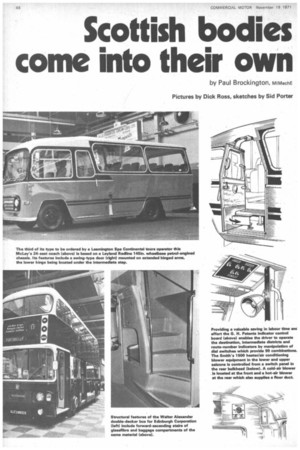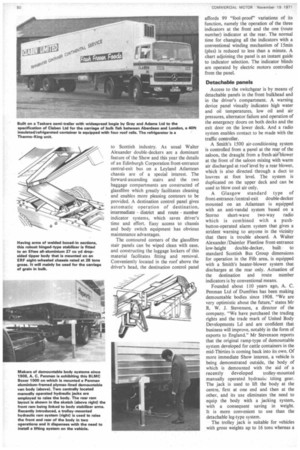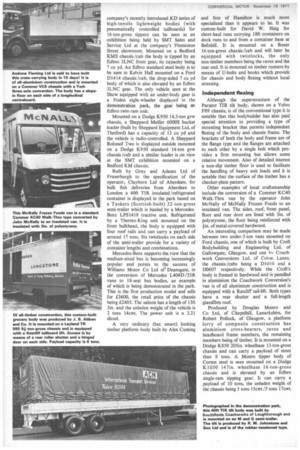Scottish bodies come into their own
Page 46

Page 47

Page 48

Page 49

Page 50

If you've noticed an error in this article please click here to report it so we can fix it.
by Paul Brockington, MIMechE
Pictures by Dick Ross, sketches by Sid Porter "SCOTTISH BODYBUILDERS are closing the gap between quality and time by exploiting craftsmanship to the full. Although they are concentrating on custom-built bodies, production times have been reduced to the minimum. And this is good for the economy of the country. More and more operators here and in the rest of the UK are wanting bodies built to meet their particular requirements. Companies south of the Border can be left to supply standard types."
The significance of this comment by Mr N. K. Douglas, commercial sales manager of Melvin Motors Ltd, Glasgow, which has a stand at the Show, is substantiated by the fact that an estimated 70 per cent of the psv and goods bodies in Kelvin Hall are built by Scottish concerns apart from the standard bodies shown by vehicle makers. Melvin are Chrysler distributors and Mr Douglas emphasizes that getting the right body for a customer is an important part of the service given by his company, which will start producing bodies for Commer and Dodge chassis at sometime in the future.
While in part the preponderance of Scottish-built bodies at the Show may be attributed to a reduction in floor space for commercial vehicle exhibits by 25 per cent compared with 1969, this is not admitted by Scottish bodybuilders. Although supporting optimism may be derived from the general confidence that Scotland will be an exporter of crude oil in the not too distant future and that the Clyde ports will later bring in more business because they can cater for the bigger ships that are coming along it seems that faith in their craftsmanship comes first.
The success story of a small Scottish bodybuilder who started producing personnel and goods bodies just over two years ago, who has since built psv for export to England and anticipates that output will be doubled in 18 months may be cited as a practical example of the "determined craftsmanship" of the Scots in the face of a faltering economy. McLay's Garage Ltd, of Kirkintilloch, Dumbartonshire, displayed a 27-seat hospitals /schools personnel carrier at Kelvin in 1969 and the company has never looked back.
Craftsmanship In the words of Mr T. Ross, the coach units manager: "McLay's is a small, private concern in a depressed area whose objective has been to create employment. The number of employees on the payroll has increased to 50 in two years and we are confident that it will have increased to 100 by early 1973. The craftsmanship is there. You wouldn't believe what we can do.
"We make anything of any type of material specified by the customer, including vans and flats. We have had inquiries from African countries and Canada. The 24-seat psv in the exhibition is the last of three delivered to West End Garage of Leamington Spa, who specialize in Continental tours. They say that a capacity of 24 seats is just on the economic limit these days and that catering for smaller parties pays off. They like petrol-engined coaches, as a lot of operators do. The engines are quieter and smoother and give more torque at low speed."
The McLay's Wayfarer 24-seat coach built for West End is of all-steel construction and is mounted on a BLMC Redline 145in. wheelbase petrol-engined chassis. It has 40 cu ft of baggage space (which is particularly useful for camping holidays) and is equipped with a Clayton Dewandre heater together with input /extractor roof ventilators. A McLay's 16-seater is derived from a standard McLay's steel-framed van but has a lower floor, a roof of increased height and a glassfibre rear end with a full-width window that comprises a reversed windscreen. McLay's also produces demountable bodies, the lifting gear of which is based on Cocker removable-leg units.
A special paint, produced by a very well-known company, was used for the finish of the Wayfarer coach. The paint, it is claimed, has highly favourable wearing properties and reistance to impact. It will be on the market next year.
Commenting on future prospects of the motor industry in Scotland and on economic prospects generally, Mr J. Hannah and Mr T. G. Hildret13, chief designer and contracts and buying manager respectively of Walter Alexander (Coachbuilders) Ltd, of Falkirk, say that things are picking up and that buoyancy is returning to Scottish industry. As usual Walter Alexander double-deckers are a dominant feature of the Show and this year the details of an Edinburgh Corporation front-entrance central-exit bus on a Leyland Atlantean chassis are of a special interest. The forward-ascending stairs and the two baggage compartments are constructed of glassfibre which greatly facilitates cleaning and enables more pleasing contours to be provided. A destination control panel gives automatic operation of destination, intermediate district and route number indicator systems, which saves driver's time and effort. Easy access to chassis and body switch equipment has obvious maintenance advantages.
The contoured corners of the glassfibre stair panels can be wiped clean with ease, and constructing the luggage lockers of this material facilitates fitting and removal. Conveniently located in the roof above the driver's head, the destination control panel affords 99 "fool-proof' variations of its function, namely the operation of the three indicators at the front and the one (route number) indicator at the rear. The normal time for changing all the indicators with a conventional winding mechanism of 15min (plus) is reduced to less than a minute. A chart adjoining the panel is an instant guide to indicator selection. The indicator blinds are operated by electric motors controlled from the panel.
Detachable panels Access to the switchgear is by means of detachable panels in the front bulkhead and in the driver's compartment. A warning device panel visually indicates high water and oil temperatures, low oil and air pressures, alternator failure and operation of the emergency doors on both decks and the exit door on the lower deck. And a radio system enables contact to be made with the traffic controller.
A Smith's 1500 air-conditioning system is controlled from a panel at the rear of the saloon, the draught from a fresh-air'blower at the front of the saloon mixing with warm air discharged at roof level by a rear blower, which is also directed through a duct to louvres at foot level. The system is duplicated on the upper deck and can be used to blow cool air only.
A Glasgow standard type of front-entrance/central-exit double-decker mounted on an Atlantean is equipped with an anti-vandal system based on a Storno short-wave two-way radio which is combined with a pushbutton-operated alarm system that gives a strident warning to anyone in the vicinity that there is trouble aboard. A Walter Alexander /Daimler Fleedine front-entrance low-height double-decker, built • to standard Scottish Bus Group dimensions for operation in the Fife area, is equipped with a Smith's heater-blower system that discharges at the rear only. Actuation of the destination and route number indicators is by conventional means.
Founded about 110 years ago, A. C. Penman Ltd of Dumfries has been making demountable bodies since 1908. "We are very optimistic about the future," states Mr R. W. J. Stevenson, a director of the company. "We have purchased the trading rights and the trade mark of United Body Developments Ld and are confident that business will improve, notably in the form of exports to England." Mr Stevenson reports that the original ramp-type of demountable system developed for cattle containers in the mid-Thirties is coming back into its own. Of more immediate Show interest, a vehicle is being demonstrated outside, the body of which is demounted with the aid of a recently developed trolley-mounted manually operated hydraulic lifting gear. The jack is used to lift the body at the centre, first at one end and then at the other, and its use eliminates the need to equip the body with a jacking system, with a consequent saving in weight. It is more convenient to use than the detachable leg-type system.
The trolley jack is suitable for vehicles with gross weights up to 16 tons whereas a derivative of a system, demonstrated at Kelvin Hall in 1969, that incorporates two centrally located manually operated hydraulic jacks is designed for vehicles in the 12/13 tons gvw category. The third type of system displayed by the company (outside) is of the hydraulically operated removable-leg type displayed at Earls Court last year and is seen applied to the body of a Ford Transit 35cwt chassis /cab. Known as the 1000 Plus, a one-piece glassfibre container is displayed in the demonstration park that is the first large capacity container to be produced by the company. It has a capacity of 1030 cu ft and a length of 18ft.
That business will improve in 1972 is the view of Mr Neville Harris, managing director of Eftee Metal Bodies Ltd of Airdrie. In the meantime producing vehicle bodies to a specification that enables the operator to run more economically is essential to maintaining profitability. Mr Harris says that this will be a continuing necessity.
An Eftee dual-purpose tipper body on display is a good example of how this policy is being put into practice. Mounted on an AEC Marshal six-wheeled chassis the body is of all-aluminium welded construction, apart from the lifting frame which is of steel, and is tipped by an Edbro single-ram gear. It was produced for a customer to carry bulk grain on long-distance runs to the South and to return with loads of bagged materials. The drop-sides are removable and together with the tailboard they are designed for stowage at the rear of the front bulkhead. A driver can remove and stow the parts without assistance. A novel feature of the body and one that is rarely specified comprises three floor chutes that are opened by hand-operated slider plates. The body has a capacity of 24 cu yd and like all Eftee bodies has very robust hinge-pin mountings.
Mounted on an ERF 689KB eight-wheeled chassis with a designed gross weight of 28 tons and plated at 26 tons, an Eftee body of the same type of construction has a capacity of 27 cu yd and is tipped by a Telehoist single-ram gear. The body is a bulk grain carrier and the sides and posts are removable but not stowable.
A third Eftee body at the Show is constructed of Corten steel, has a capacity of 9 cu yd and is mounted on an Albion Clydesdale 16-ton-gross chassis of 12ft wheelbase. Mr Harris states that the body weighs 2cwt more than an aluminium counterpart and costs ENO less. He reports that bodies of this type are finding increasing favour in Scotland.
Making its debut in Glasgow during the Show, an Edbro drop-sided version of the company's recently introduced KD series of high-tensile lightweight bodies (with pneumatically controlled tailboards) for 16-ton-gross tippers can be seen at an exhibition being held by SMT Sales and Service Ltd at the company's Finnieston Street showroom. Mounted on a Bedford KMS chassis/cab the body is tipped by an Edbro 3LNC front gear, its capacity being 7 cu yd. An Edbro standard steel body is to be seen in Kelvin Hall mounted on a Ford D1414 chassis /cab, the drop-sided 7 Cu yd body of which is also elevated by an Edbro 3LNC gear. The only vehicle seen at the Show equipped with an under-body gear is a Foden eight-wheeler displayed in the demonstration park, the gear being an Edbro twin-ram unit.
Mounted on a Dodge K950 14.5-ton gvw chassis, a Sheppard Meiller 6000S bucket loader (built by Sheppard Equipment Ltd, of Thetford) has a capacity of 12 cu yd and the vehicle is radio-controlled. A Sheppard Rolonof Two is displayed outside mounted on a Dodge K950 standard 14-ton gvw chassis /cab and a similar loader is on view at the SMT exhibition mounted on a Bedford KM chassis.
Built by Gray and Adams Ltd of Fraserburgh to the specification of the operator, Clayburri Ltd of Aberdeen, for bulk fish deliveries from Aberdeen to London a 40ft TIR insulated/refrigerated container is displayed in the park based on a Taskers (Scottish-built) 32-ton-gross semi-trailer which is hauled by a MercedesBenz LPS1418 tractive unit. Refrigerated by a Thermo-King unit mounted on the front bulkhead, the body is equipped with four roof rails and can carry a payload of around 17 tons. Six twistlocks on each side of the semi-trailer provide for a variety of container lengths and combinations.
Mercedes-Benz supports the view that the medium-sized bus is becoming increasingly popular and points to the success of Williams Motor Co Ltd of' Deansgate, in the conversion of Mercedes L406D /35R vans to 18-seat bus bodies, an example of which is being demonstrated in the park. This is the first production model and sells for £3600, the retail price of the chassis being £2405. The saloon has a length of 13ft 3M. and the unladen weight of the vehicle is 2 tons 14cwt. The power unit is a 2.21 diesel.
A very ordinary (but smart) looking timber platform body built by Alex Cuming and Son of Hamilton is much more specialized than it appears to be. It was custom-built for David W. Haig for short-haul runs carrying 18ft containers on dock runs to and from a container base at Bellshill. It is mounted on a Boxer 16-ton-gross chassis /cab and will later be equipped with twistlocks, the only non-timber members being the raves and the rear end. It is mounted on timber runners by means of' U-bolts and hooks which provide for chassis and body flexing without local stressing.
Independent flexing Although the superstructure of the Parator TIR tilt body, shown on a Volvo F89 chassis, is of the conventional type it is notable that this bodybuilder has also paid special attention to providing a type of mounting bracket that permits independent flexing of the body and chassis frame. The brackets of both the body and frame are of the flange type and the flanges are attached to each other by a single bolt which provides a firm mounting but allows some relative movement. Also of detailed interest a non-slip timber floor is used to facilitate the handling of heavy unit loads and it is notable that the surface of the timber has a checker-plate pattern.
Other examples of local craftsmanship include the conversion of a Commer KC40 Walk-Thru van by the operator John McNally of McNally Frozen Foods to an insulated van. The sides, roof, front panel, floor and rear door are lined with 3in. of polystyrene, the floor being reinforced with fin. of metal-covered hardwood.
An interesting comparison may be made between two under-3-ton vans mounted on Ford chassis, one of which is built by Croft Bodybuilding and Engineering Ltd, of Gallowgate, Glasgow, and one by Coachwork Conversions Ltd, of Celtic. Lanes, the chassis/cabs being a D1010 and a D0607 respectively. While the Croft's body is framed in hardwood and is panelled in aluminium the Coachwork Conversion's van is of all aluminium construction and is equipped with a Ratcliff tail-lift. Both types have a rear shutter and a full-length glassfibre roof.
Produced by Douglas Munro and Co Ltd, of Chapelhill, Lanarkshire, for Robert Pollock, of Glasgow, a platform lorry of composite construction has aluminium cross-bearers, raves and headboard frame members, the remaining members being of timber. It is mounted on a Dodge 1(850 205in. wheelbase 13-ton-gross chassis and can carry a payload of more than 8 tons. A Monro tipper body of Corten steel is seen mounted on a Dodge K1050 147in. wheelbase 16-ton-gross chassis and is elevated by an Edbro single-ram tipping gear. It can carry a payload of 10 tons, the unladen weight of the chassis being 5 tons I5cwt /5 tons I7ewt.




















































































































